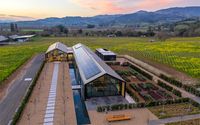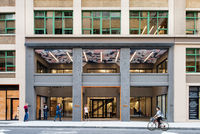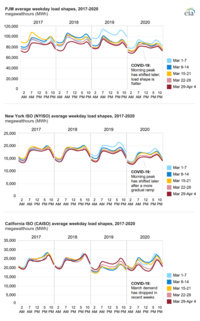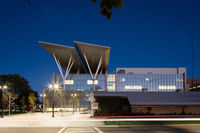News Brief
Significant challenges prevent the great majority of existing NYC multifamily buildings from being electrified, but these 480 buildings are prime candidates.
While some small buildings have taken to electrification retrofits, large multifamily buildings have been a harder nut to crack. Seeing “virtually no progress in this sector” in New York City, the Urban Green Council studied the reasons why and released a report detailing the existing multifamily building type that could... Read more
News Brief
Stimulating the building industry is crucial to getting out of a recession, but let’s do it right, says the Canada Green Building Council.
Almost half the households in Canada have lost income due to the COVID-19 pandemic, catalyzing a severe recession that will be hard to get out of. Typically, infrastructure and building projects create vital jobs that aid recovery, but the Canada Green Building Council (CaGBC) is calling on the Canadian federal government to... Read more
Product Guide
Medium-density fiberboard and particleboard are non-structural panels manufactured from sawmill waste that is typically held together with phenol formaldehyde (PF), melamine formaldehyde (MF), or urea formaldehyde (UF), resins. Formaldehyde-free methylene diphenyl diisocyanate (MDI) resins are also used.
Particleboard is made from... Read more
Webcast
Whole-building life-cycle assessment (WBLCA) can help project teams reduce embodied carbon as well as many other environmental impacts of building materials. And it’s incentivized in LEED and other rating systems. But how do you do it? In this course, we’ll review the basics of WBLCA and then look in-depth at two software tools for conducting... Read more
Webcast
Dr. Gail Brager, Professor of Architecture at UC Berkeley, discusses the value of (mostly thermal) variability in terms of human experience, and implications for design of the built environment.
Gail begins with a visual argument for why variability is important, followed by some research examples showing evidence of the positive and... Read more
Product Review
Renewable energy systems, particularly photovoltaic (PV) panels, have come under attack for using toxic materials and having a high carbon footprint. The truth is more complicated.
As planet temperatures continue to rise, reducing carbon emissions from fossil fuel consumption is now our biggest challenge. Photovoltaic (PV) energy is often held up as our future.
Though PV already has a long history of solid performance, articles claiming PV is actually a net producer of carbon have been circulating for years. Other... Read more
Op-Ed
How will the AEC industry—what we build and how we work—change post-pandemic? We asked leading lights in the green building world.
Downtown Chicago, like so many downtowns, has been largely empty to prevent the spread of Covid-19—followed more recently by protests and opportunistic looting (Central Camera, visible in this image, was badly damaged).
Photo: Raed Mansour. License: CC BY 2.0.We queried some big-picture thinkers, and we got... Read more
News Brief
A team entirely new to Living Building Challenge successfully molded what is usually a water-intensive production facility to meet the highest of performance standards.
The International Living Future Institute recently certified the largest Living Building yet—the Alexander Valley Silver Oak Winery in California. This 109,000-ft2 facility consists of tasting rooms, a wine cellar, and production facilities, making it a relatively complicated project compared to others that have pursued the Living Building... Read more
Feature
Take a plain old building and turn it into something remarkable, and you’ll also help save the planet.
Older buildings—especially those from the 1950s, ’60s, and ’70s—need our help. Many leave something to be desired in terms of aesthetics and comfort. But the truth is that they are part of the urban and suburban fabric now, and they aren’t going anywhere. As tempting as it might seem to tear them all down and replace them with... Read more
News Analysis
From handwashing signage to humidification, here’s how the building industry can help combat the spread of infectious disease.
Lactation rooms, circadian lighting, nutritious food, and inviting stairways: through Fitwel and WELL, these have become more common ways to promote wellness through building design and operations. But what do these certifications have to say about illness? And specifically, about stopping the spread of COVID-19?
Fitwel:... Read moreNews Brief
ASTM C1866 will make it easier to specify low-embodied-carbon recycled ground glass as a supplementary cementitious material.
Ground glass can be a low-global-warming-potential replacement for portland cement, but using it on a project has been difficult because there has been no standard way to specify the material. ASTM has published ASTM C1866, Standard Specification for Recycled Ground-Glass Pozzolan for Use in Concrete. ASTM C1866 will make it... Read more
Webcast
What weather data are you using to inform design? Learn where to access high-resolution climate projection data for your projects, and how to use it. Be an early adopter as the AEC industry moves from considering weather as static to using information about our changing climate to inform design.
News Analysis
Daylight, indoor/outdoor spaces, extensive plantings, and exposed wood are among the features of this year’s winners.
The American Institute of Architects Committee on the Environment (COTE) has announced its Top Ten projects for 2020. If one theme shows through, it’s the almost universal embrace of natural daylight and plantings, along with commonalities like exposed wood and indoor/outdoor spaces.
Two awards went... Read more
News Brief
A life-cycle assessment of Katerra cross-laminated timber reveals opportunities for lower carbon impact.
Want to lower the carbon footprint of a mass-timber structural system? Consider the species of the lumber and where it’s coming from.
That’s one of the central conclusions of a life-cycle assessment (LCA) recently published in the journal Sustainability and summarized in a report by Katerra.... Read more
News Brief
The United Church of Christ says there is a moral urgency to tame toxic emissions from 100 plants located in populated areas.
In a recent report, The United Church of Christ, a denomination of Protestant Christianity, shames 100 U.S. manufacturing facilities with highly toxic air pollution records, calling it a “moral crisis” that more than 112,500 children under the age of five live within three miles of the facilities’ perimeters.
... Read moreNews Brief
The Illuminating Engineering Society’s white paper “Germicidal Ultraviolet (GUV)–Frequently Asked Questions” explains GUV and its potential role in fighting COVID-19.
The Illuminating Engineering Society (IES) has released the white paper “Germicidal Ultraviolet (GUV)–Frequently Asked Questions.” The report is aimed at healthcare applications, addressing the fundamentals of GUV light, its effectiveness, its safety, and more in the age of the COVID-19 pandemic.
... Read more
News Analysis
Flattening the COVID curve is also flattening electricity load curves, which may be a lesson for the building industry.
Just as COVID-19 has changed nearly every aspect of day-to-day life, the virus is upending deeply rooted patterns of the electric grid. Combined with initial signs of cleaner air, emboldened wildlife, and growing demand for local agriculture, some have wondered whether being confined to our homes has resulted in lower... Read more
Product Review
Cleaning with soap and water is still the best defense against COVID-19 virus and other pathogens. Antimicrobials are not the answer.
COVID-19 self-isolation has drastically changed our behavior. We don masks and rubber gloves if we have to go outside and then wash hands incessantly when we get back … behaviors that would have seemed absurd just a few months ago. The precautions are well founded as we look for ways to “flatten the curve” and get a handle on... Read more
News Brief
Older buildings are “CFC banks” because of phased-out refrigerants and blowing agents, according to MIT scientists.
The hole in the ozone layer is closing—but not as quickly as it should, according to researchers at the Massachusetts Institute of Technology (MIT). In fact, buildings with older foam insulation, HVAC systems, and refrigeration equipment could delay healing by six years. The escaping CFCs (chlorofluorocarbons) are blowing... Read more
News Brief
Measuring embodied carbon is no longer enough: certified projects now must purchase offsets for embodied carbon and refrigerant leaks.
The Canada Green Building Council (CaGBC) was the first to launch a national standard for carbon neutrality in buildings. Now version 2 has been released with changes that include multiple compliance paths for energy efficiency, a requirement to offset fugitive refrigerant emissions and embodied carbon, and a higher bar for carbon offsets. The... Read more







